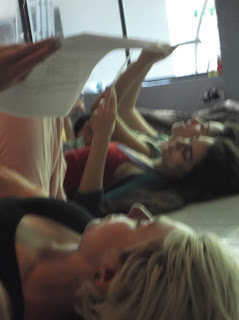Working with Michael Klien, day 1.
We begin with introductions, the labbers are joined by four visitors, including Nefeli (labber 2011), this is great, two post labbers. Nefeli and Eleni have re-engaged, bringing a continuity/evolution to the long term identity of the lab.

Michael likes to start with speaking. Defining choreographic approaches -representational, structural, epistemological (how do things come into being-flow, education, knowledge). What 'nutrients' does each process bring to the human condition to or life. Not a matter of right or wrong but of choice. But there are dominances.
Then there is social dreaming...within the Tavistock Institute, where people share their dreams, with no reference to the dreamer, but the dream itself, free associations, if you do this over days, it becomes a matrix, with its own commonalities...shared symbols. Establishment of a common reality through the dream ...dreaming is a constant state; at night the inhibitors are down, then we notice that we are reading. The inhibitors are day to day reality, growing, in the stream of everything... out of this stream 'reality' springs and separates itself from the 'dream'... insanity perhaps a constant state of dreaming. ... we remember the historical connection between art, insanity and dreaming, strategies of coping.... In social dreaming everyone is creative, not just artists. Important to this is the idea of emergence...signs, language, relationships that emerge, created. 'Everybody is an artist' (
Josef Beuys).
We start dancing. Just dancing. Fifteen minutes of just dancing....15 minutes later...he asks: from all that time, during how much of it did you really really really dance? Kiani interjects "it depends what we call dance".... so she says 15 minutes. For Thania, from 45 seconds to 15 minutes... Michael: have you ever danced more in your life? do you feel that you have danced in your life more intensely than this that you have done now..' murmurs of 'of course'..... so... the next thing to do is: to 'really dance'...only 7 minutes, really really dance.
Time to discuss. Lots of questions about the implications of Michael's proposals. Particularly about the 'most intense'... Michael brings the issue of 'experience' in relation to intensity. The group questions (for a first time?) Michael's proposals.... great. For Michael 'the best dancing' happens when you know what it takes to arrive at the 'real dancing'... to be aware of the conditions that are set, can be set, to make dance happen. Notice the change of movement as conditions change. He speaks of a 'drop', does it always have to be a 'drop'? not drop as such 'a transformation'.
Last conceptual push: 'dance as sheltered by philosophy'.
Alain Badiou walks through the door holding
A Handbook of Inaesthetics.
Dance as a metaphor for thought. How dance relates to thinking. Not dance as institutional arrangement. Philosophy has a notion of dance, reminiscent of early childhood, a certain kind of phenomena (Nietzche and Mallarme). Dance as a disclosure of
being. Even spiritual if you want to take it that far. Proprietor of one's experience. Badiou says
'dance against gravity', what is that....? Badiou's poetic provocation...gravity of organisational structures, what pulls in one direction. State of dance moves against this state (s) of gravity. Need for space: that can extend itself to its 'proper height', whatever/where ever it needs to extend, a measure of its essence. The place where the
body becomes its own forgetting, forget that one is dancing (because it becomes pure being not needing its own awareness?). Dance is a search, once there is an event there is theatre, not dance.
Dance is the possibility of art as inscribed in the body...therefore it is continuous, this moment, this situation.
Dance is always a new name given to the Earth. Complex thought body, where it internal relations go into a state of flux, relations are flexible, not repeating, change...each arrest gives results in a new constellation, reoccurring, re-establishing itself and its known connections into the new.
To make connections he describes recent events:
Silent Witness (in the Irish Parliament) and
A Man Dancing (Museum of Modern Art, Dublin) last year.
Question from Angela: back to intensities, is it what we need, or work against conditions to be encountered, to dance in spite...response: you are then a proficient dancer... mediating, meeting the demands of sharing, with what is personally needed. perhaps a mixture of both. Practice [of] changes.
Technology of the self.
It is proposed that we go back to respond to the question 'how much dancing did you really do?' (in the 7 mins exercise), and having listened to MK, the answers are revisited. it is not the intensity but what is the 'really really'... Thania: degree of connection not necessarily intensity, but intensities in/of.... tangibility about concreteness, concreteness a type of 'representation'.
Thania comments: if dance is not a language, why are we talking so much and not moved? where all all these thoughts in the act of dance? Good point/ This is the challenge of havimg a dance therapist/choreographer/dancer in the midst. she is good with methodologies, finding the gaps the contradictions..... what are they? what do we do when we face these contradictions? what thought does it bring? what action does/can they motivate?
Scores//////moving////tomorrow/





































.jpg)











